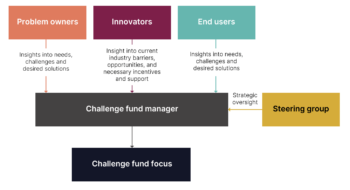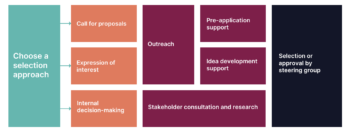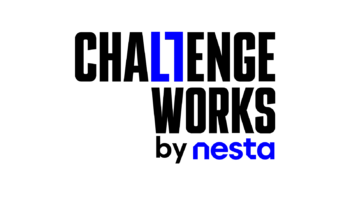News – Thought Leadership
Designing challenge funds
22 August 2022
- Teodora Chis
How are challenge prizes designed?
Over the past months, we spoke to experts and colleagues who have designed, delivered or evaluated challenge funds – including examples such as the London Mayor’s Resilience Fund, the Ofwat Innovation Fund, the Climate Smart Cities Challenge, the Cardiff Capital Region Challenge Fund, and the Industrial Strategy Challenge Fund.
Thanks to this research, we’ve been able to distil key practical and theoretical recommendations for how to design effective challenge funds.
While each challenge fund is different, some key questions will invariably guide the design process:
- What is the challenge fund about, and what does it seek to achieve, i.e. what is the challenge fund focus?
- How does one go from a challenge fund into a series of challenge calls?
- How are innovators selected, and how is funding awarded?
- How will the challenge fund incentivise and support innovators to participate and deliver their best solutions?
Understanding who designs the challenge fund
At their best, challenge funds bring together diverse groups of stakeholders around a problem. Not only does this ensure that innovation happens – it also ensures that it is targeted toward solving issues that are relevant for society.
Integrating the insights of multiple stakeholders groups, however, is not an easy task. Some risks that funders may encounter include:
- A lack of proper stakeholder engagement built into the design process. In the absence of mechanisms to bring problem owners, innovators, and end-users on-board, the challenge fund may not reflect their actual needs and contexts. Overall, a bottom-up approach to engage these groups can ensure a better understanding of the challenge fund’s focus problems, and generate legitimacy and buy-in at an early stage.
- A lack of strategic direction. On the other hand, maintaining a strong focus on the main issue that the challenge fund is trying to solve is important; losing oversight of it can result in a piecemeal approach to the challenge fund, an incoherent portfolio of investments, and in funding and activities being duplicated.
- Bias toward certain stakeholders, particularly those that are well-represented in the field that the challenge fund takes place in. For instance, industry players who are familiar with navigating the innovation funding space may have their voices overrepresented in the design process, whereas the “unusual suspects” or end-users may be left aside.
How can funders overcome these barriers?
On the one hand, we recommend conducting robust research and diverse stakeholder engagement from the very beginning, to set the focus of challenge funds, articulate the intended impact and identify the appropriate funding mechanisms.
On the other hand,integrating the bottom-up engagement and co-design within a broader strategic framework, ensuring that any directions given by the participatory process are aligned to existing priorities.
Our proposed approach to this is summarised in the figure below.

Translating the challenge fund into a series of calls
Deciding on the focus of a challenge fund is a crucial step. However, how exactly that focus is operationalised through challenge calls is equally important – it determines what types of solutions funders seek, who are the innovators that will develop them, and how they will be awarded funds.
While there is no standard process for this, we have found three broad approaches that challenge funds tend to take.
- Call for proposals. The challenge fund manager advertises a call for proposals that problem owners can respond to within a specified timeframe. In some cases, pre-application support is offered to ensure that problem owners put forward well-developed proposals tailored to the challenge fund goals. A selection panel decides which individual calls will become part of the challenge fund.
- Expression of interest. Problem owners are invited to submit ideas for challenge calls. A selection panel reviews the proposals by wave, deciding according to a transparent series of criteria whether they should move forward and further develop the idea (or combine it with other proposals that may be tackling the same or similar problems). The challenge fund manager then leads the design of the challenge call according to this input, with the support of the problem owner.
- Internal decision-making. The challenge fund manager, in close collaboration with the steering group, designs a series of challenge calls drawing on insights from research, evidence, and stakeholder engagement processes.

Each of these approaches comes with its own set of advantages and challenges.
- For instance, setting up a call for proposals is a great way to create a structured framework within which fund managers get problem owners to articulate detailed ideas for challenge calls, and select the most relevant entries. However, this approach can sometimes prove to be rigid, and may run the risk of outsourcing the weight of designing the calls to problem owners that may lack the time and resources to do so.
- Alternatively, an expression of interest approach may address some of these shortcomings by taking a more co-creative approach to designing the calls. However, funders should be aware that translating expressions of interest into fully designed challenge calls can be a labour-intensive process that requires a high level of expertise – and should therefore be ideally used when timelines allow for proper co-design.
- Lastly, while internal decision-making can allow challenge fund managers to fully own the call design process, and to create a bespoke portfolio of calls that complement one another, it will require spending a considerable amount of time engaging stakeholders and ensuring that calls are relevant answers to their needs.
Conclusion
The design of challenge funds can be a complex process that features many moving pieces and decision points. And, most importantly, it will determine whether the funding available is spent in the most impactful way.
Unsurprisingly, throughout our engagement with experts and colleagues, ensuring the appropriate resourcing for design has emerged as one of the key insights. This means spending the right amount of time to listen to what different stakeholders want and need – including those whose problems the challenge fund is trying to solve, and the innovators that will bring solutions to the table – and iterating plans accordingly.
It also means taking important decisions, such as the approach to operationalising challenge funds, as described above, or the choice of funding instrument (whether it is a challenge prize, a grant, an investment, or something else) – which we explore in our next blog post.
Categories
-
![Invitation to tender]()
INVITATION TO TENDER: redevelopment and monthly hosting and maintenance of Challenge Works websites
Careers & Tenders
-
![WYCA Innovators]()
Big ideas, bright futures: Meet the 19 finalists shaping a healthier West Yorkshire
-
![transp-brain-Web-Large-16x9]()
Launching the £7.5 million Longitude Prize on ALS
-
![2025-05-29- Challenge Works Manchester Prize-44]()
10 AI-powered solutions announced for the Manchester Prize: Clean Energy Systems
-
![SDCP - Couple]()
Introducing the 10 Smart Data Challenge Prize finalist teams
-
![GSC-HERO-SEAsia-2-1920x1080]()
Introducing the Good Start Challenge






